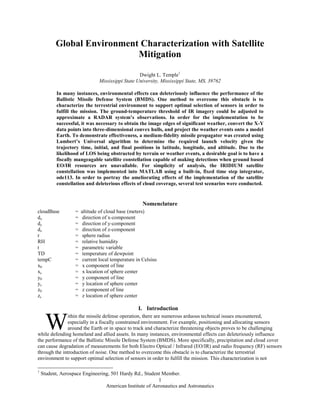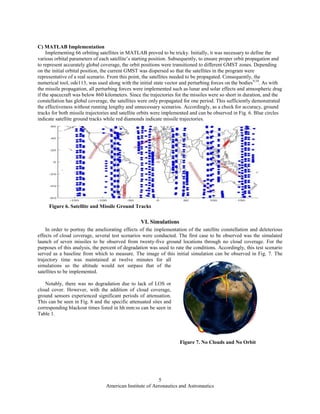The document discusses methods for characterizing the global environment using satellite data to help overcome challenges posed by weather effects on missile defense sensors. It describes adjusting infrared imagery thresholds to approximate radar observations, extracting weather event boundaries, projecting 3D shapes onto a model Earth, and using an existing satellite constellation to provide continuous coverage. The goal is to determine visibility and sensor performance to optimize sensor selection and placement for missile defense.

![American Institute of Aeronautics and Astronautics
2
arbitrary; therefore, assumptions must be made regarding sensor performance. (Numerous sources have shown that
the attenuation due to atmospheric effects such as intense precipitation is severe enough to hamper completely
EO/IR performance.)1
Therefore, for the purposes of this analysis, any significant weather will be considered to
attenuate the sensor performance by 100%. Based on this assumption, the sensor becomes effectively useless and
wastes the precious battle-space resource of time. In addition to environment characterization, the implementation of
a small-satellite constellation to provide continuous global coverage can ameliorate coverage gaps due to weather
events or insufficient line of sight.
II. Determining Line of Sight
Determining line of sight may seem like a trivial matter; however, there are sophisticated methods of
approaching the issue. As a result, the accurate line of sight (LOS) vector can be obtained and subsequently used in
further calculations such as triangulated intersections. For this MATLAB model, the method used for LOS was a
three-dimensional quadratic equation.2
This allows for the accurate determination of a ray intersection of one or two
spheres, depending on what is desired. In order to determine LOS between a missile trajectory and the Earth, one
sphere (the Earth) was used. Using Eq. 1 shown below, the terms can be expanded and grouped by the parametric
term, t, as shown in Eq. 2.
(𝑥0 + 𝑑 𝑥 ∗ 𝑡 − 𝑥 𝑐)2
+ (𝑦0 + 𝑑 𝑦 ∗ 𝑡 − 𝑦𝑐)
2
+ (𝑧0 + 𝑑 𝑧 ∗ 𝑡 − 𝑧 𝑐)2
= 𝑟2
(1)
[𝑑 𝑥
2
+ 𝑑 𝑦
2
+ 𝑑 𝑧
2
]𝑡2
+
[2𝑑 𝑥(𝑥0 − 𝑥 𝑐) + 2𝑑 𝑦(𝑦0 − 𝑦𝑐) + 2𝑑 𝑧(𝑧0 − 𝑧 𝑐)]𝑡
[𝑥0
2
+ 𝑥 𝑐
2
− 2𝑥0 𝑥 𝑐 + 𝑦0
2
+ 𝑦𝑐
2
− 2𝑦0 𝑦𝑐 + 𝑧0
2
+ 𝑧 𝑐
2
− 2𝑧0 𝑧 𝑐] = 𝑟2
(2)
Congruent with the quadratic formula, each of the coefficients of “t” becomes the terms, “a”, “b”, and “c”,
respectively. The pertinent result is the sign of the discriminant. For example, if the discriminant is positive, there
are two intersections of the line and sphere; likewise, if it is negative, there are no intersections on the sphere.
Notably, if the discriminant is zero, there is exactly one intersection at the surface. When performing numerous LOS
calculations, an effective and repeatable method of determining visibility is necessary for accuracy. An example of
the line segment and sphere intersection is shown below in Fig. 1. It varies case-by-case; however, this is an
example of one intersection with the sphere; therefore, there is no line of sight.
III. Environment Characterization
In order to characterize the environment, specific limiting
factors were defined. Foremost, all analysis were completed
using publically available information because access to global
radar data was unavailable. However, there was open-sourced
global infrared imagery available from Weather Underground.
The reasoning behind using available weather information results
from the method of weather information acquisition.
Geosynchronous satellites use a variety of sensors; one of these
sensors is an IR camera. Therefore, one can observe the imagery
from the satellite and determine where a typical ground-based IR
sensor can and cannot be used. If the geosynchronous satellite
cannot observe the ground using IR, then it was assumed an IR
sensor on Earth could not observe through the same attenuating weather. Of course, this does not solve the issue
regarding RADAR attenuation; however, there was an approximation available. The ground-temperature threshold
(GTT) of the IR imagery could be adjusted to approximate a RADAR system’s observations. GTT is the sensitivity
of the IR sensor to temperature of the foreground versus the background such as the cloud versus the ground
temperature. The result was an image that resembled a RADAR observation; consequently, this resulting image,
shown in Fig. 2, was used in further analysis.
Figure 1. Intersection of Line Segment
and Sphere](https://image.slidesharecdn.com/ee50bf2d-95cf-4b9c-8ab4-fb993da86183-161004012935/85/AIAA-Paper-dlt228-2-320.jpg)




![American Institute of Aeronautics and Astronautics
7
References
1
Yates, H. W., Taylor, H. J., “Infrared Transmission of the Atmosphere” U.S. Naval Research Laboratory., Rept 5453,
Washington D.C., June 8, 1960.
2
Bourke, P., “Intersection of a Line and a Sphere.” (November 1992) (http://paulbourke.net/geometry/circlesphere/)
[Cited January 13, 2016].
3
Lawrence, G. M., “The Relationship between Relative Humidity and the Dewpoint Temperature in Moist Air.” Max Planck
Institude for Chemistry, Mainz, Germany, 2004. [Cited January 10, 2016].
4
Iyer, Shiva (27 Dec 2013) Solve Lambert’s Problem in Two-Body Dynamics
(http://www.mathworks.com/matlabcentral/fileexchange/44789-solve-lambert-s-problem-in-two-body-dynamics) MATLAB
Central File Exchange. [Cited September 15, 2015].
5
Vallado, D. A., Fundamentals of Astrodynamics and Applications, McGraw-Hill, New York, 1997.
[Cited September 10, 2015].
6
Iridium. “Iridium Next Constellation.” (November 14, 2012)
(http://www.esa.int/spaceinimages/Images/2012/11/Iridium_NEXT_constellation) . [Cited January 17, 2016].
7
Pratt, R. S., Raines, A. R., Fossa, E. C., Temple, A. M., “An Operational Performance Overview of the IRIDIUM Low Earth
Orbit Satellite System.” (Q2 1999) (http://kt.agh.edu.pl/~brus/satelity/Iridium-Leo.pdf). [Cited October 20, 2015].
8
NASA Goddard Space Flight Center (5 May 2014) NASA Solicitation: Visible and IR Camera Systems For Low Earth Orbit,
GEO, and Interplanetary Spaceflight. (http://www.spaceref.com/news/viewsr.html?pid=45664) [Cited December 10, 2015].
9
Cabrera, N., “MATLAB GUI Visualization of Classical Orbital Elements.” California Polytechnic State University, San Luis
Obispo, California, 2010. [Cited September 10, 2015].
10
Frees, E., “An Analysis of N-Body Trajectory Propagation.” California Polytechnic State University, San Luis Obispo,
California, 2010. [Cited September 3, 2015].
11
Gruss, M., “Lockheed Martin Examines Cost-cutting Options for SBIRS.” (December 8, 2014)
(http://spacenews.com/42887lockheed-martin-examines-cost-cutting-options-for-sbirs/) [Cited January 20, 2016].](https://image.slidesharecdn.com/ee50bf2d-95cf-4b9c-8ab4-fb993da86183-161004012935/85/AIAA-Paper-dlt228-7-320.jpg)